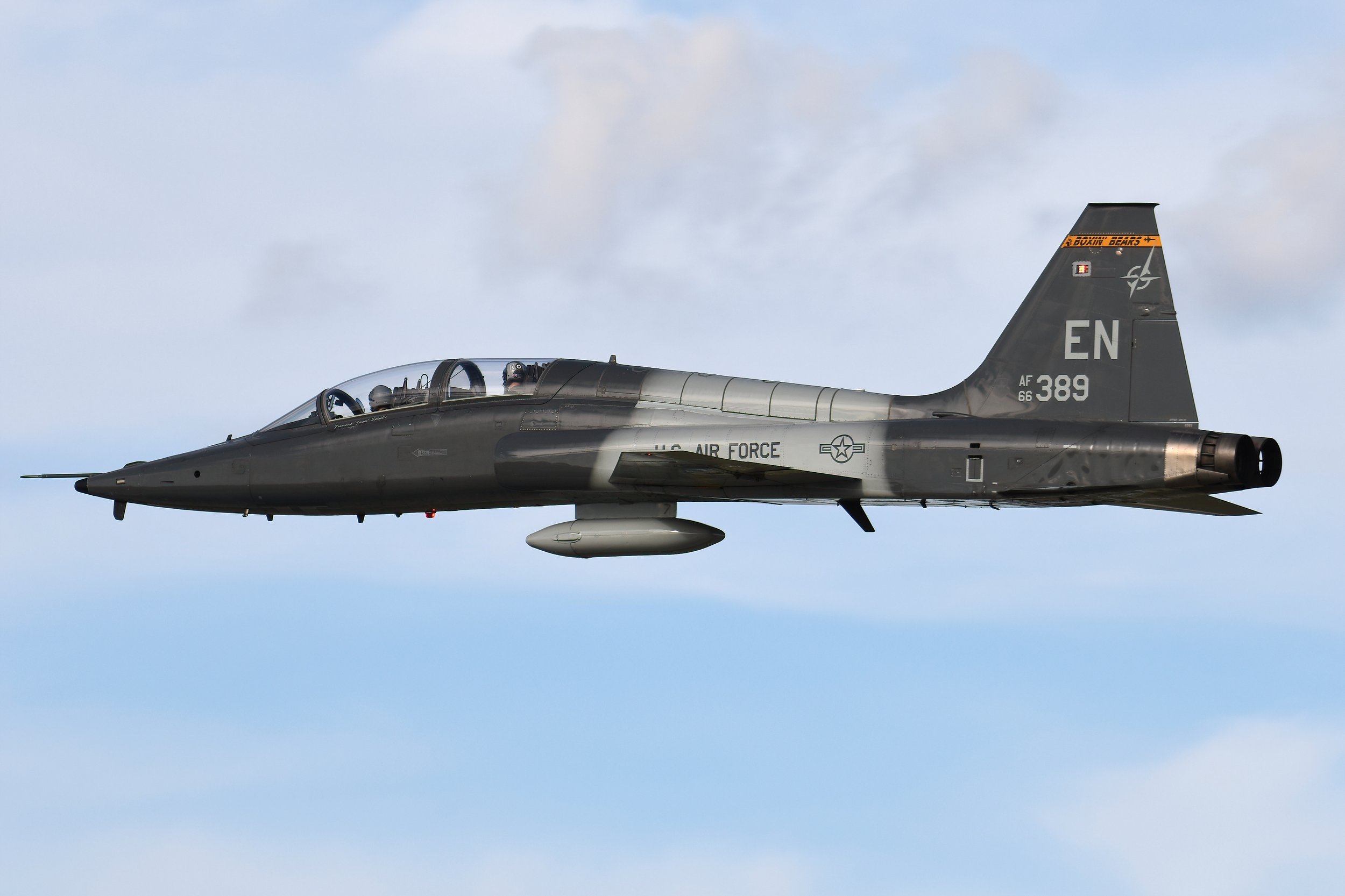
April 10 / Northrop T-38 Talon first flight
First Flight 10 April 1959
Northrop T-38 Talon
The Northrop T-38 Talon is a two-seat, twinjet supersonic jet trainer designed and produced by the American aircraft manufacturer Northrop Corporation. It was the world's first supersonic trainer as well as the most produced.
The T-38 can be traced back to 1952 and Northrop's N-102 Fang and N-156 fighter aircraft projects. During the mid-1950s, Northrop officials decided to adapt the N-156 to suit a recently issued general operating requirement by the United States Air Force (USAF) for a supersonic trainer to replace the Lockheed T-33. The bid was successful, in no small part on its lower lifecycle cost comparisons to competing aircraft, and the company received an initial order to build three prototypes. The first of these, designated YT-38, made its maiden flight on 10 April 1959. The T-38 was introduced to USAF service on 17 March 1961.
The USAF is the largest operator of the T-38. Additional operators of the T-38 include NASA and the United States Navy. U.S. Naval Test Pilot School in Patuxent River, Maryland, is the principal US Navy operator. Other T-38s were previously used by the US Navy for dissimilar air combat training until replaced by the similar Northrop F-5 Tiger II. Pilots of other NATO nations have commonly flown the T-38 during joint training programs with American pilots.[1] The T-38 remains in service as of 2023 with several air forces. As of 2023, the T-38 has been in service for over 60 years with the USAF, its original operator. In September 2018, USAF announced the replacement of the Talon by the Boeing Saab T-7 Red Hawk.
In 1952, Northrop began work on a fighter project, the N-102 Fang, with shoulder-mounted delta wing and a single engine. The proposed General Electric J79 engine, weighing nearly two tons, meant the resulting aircraft would be large and expensive. During 1953, representatives from General Electric Aviation's newly created Small Aircraft Engine Department showed Northrop a relatively compact engine, around 400 lb installed weight, capable of 2,500 lb of thrust. Upon seeing the engine, Northrop VP-Engineering Edgar Schmued saw the possibility of reversing the trend toward the large fighters.
Schmued and chief engineer Welko Gasich decided on a small, twin-engined "hot-rod" fighter, the N-156. Northrop launched its N-156 project in 1954, aiming for a small, supersonic fighter jet capable of operating from the US Navy's escort carriers. When the Navy chose not to pursue equipping its fleets in such a fashion, favoring large fleet carriers instead, Northrop opted to continue work on the N-156 using in-house funding. It was instead recast as a lightweight fighter, referred to as the N-156F, that was primarily aimed at the export market.
In the mid-1950s, the USAF issued a general operating requirement for a supersonic trainer, seeking to retire its 1940s-era Lockheed T-33s for an aircraft better suited to training pilots to fly its high speed fighter aircraft. Northrop officials decided to adapt the N-156 to this competition. The only other candidate was the two-seat version of the North American F-100 Super Sabre. Although the F-100 was not considered the ideal candidate for a training aircraft (it is not capable of recovering from a spin), NAA was still considered the favorite in the competition due to that company's favored-contractor status with the USAF, but Northrop officials presented lifecycle cost comparisons that proved to be highly persuasive amongst USAF officials. Accordingly, Northrop was awarded an initial contract in June 1956 to produce three prototypes, designated YT-38.
On 10 April 1959, the first YT-38 performed its maiden flight at the hands of test pilot Lew Nelson.
The type was quickly adopted. The first production examples were delivered in 1961, entering service on 17 March 1961, complementing the Cessna T-37 Tweet primary jet trainer. When production ended in 1972, 1,187 T-38s had been built, plus two N-156T prototypes. Since its introduction, an estimated 50,000 military pilots have trained on this aircraft. The USAF remains one of the few armed flying forces using dedicated supersonic final trainers, as most, such as the US Navy, use high-subsonic trainers.
During 1962, the T-38 set absolute time-to-climb records for 3,000, 6,000, 9,000, and 12,000 meters, beating the records for those altitudes set by the F-104 in December 1958. The F-4 Phantom beat the T-38's records less than a month later.
The majority of T-38s built were of the T-38A variant. The USAF had a small number of aircraft converted for weapons training, designated AT-38B, which were fitted with a gunsight and could carry a gun pod, rockets, or bombs on a centerline pylon. By the end of September 2017, 503 T-38s were still operational with the USAF, while many more remained in operation around the world.
Most of the USAF's aircraft, T-38A and AT-38B, have been converted to the T-38C through an avionics upgrade program. Improvements include the addition of a head-up display, global satellite positioning, inertial navigation system, and traffic collision avoidance system. Most aircraft have received a propulsion modification to improve low-altitude engine thrust. Around a third of the fleet, those that experience more severe usage, are currently undergoing structural replacements and upgrades, as well as receiving new wings, to extend their service life to 2029.
The fighter version of the N-156 was selected for the US Military Assistance Program and produced as the F-5 Freedom Fighter. Many of these have since reverted to a weapons-training role, as various air forces have introduced newer types into service. The F-5G was an advanced single-engined variant later renamed the F-20 Tigershark. In 2018, the Iranian Air Force announced that an outwardly similar aircraft, named the Kowsar, had been constructed within Iran.








